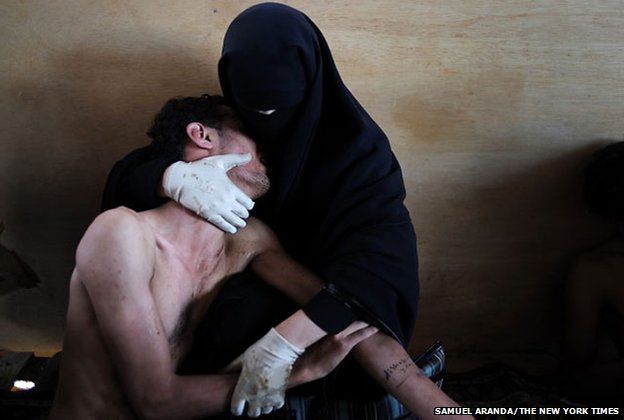The story behind the World Press Photo
- Published
- comments

This photograph by Spanish photographer Samuel Aranda was recently awarded first place in the World Press Photo Award and has gone on to generate many column inches of analysis and debate.
It is a powerful picture, both in terms of the content and aesthetics. The pose has been likened to Michelangelo's Pieta and the Renaissance style of lighting elevates it from an illustrative news picture to something that has a heritage.
Yet of course, it was just one of 100,000 entries to this year's World Press Photo competition and follows in the footsteps of other winners of a similar nature, including Georges Merillon's picture from 1990 and Hocine's 1997 winner. Both have similar painterly qualities and depict moments of high emotion. The scars of conflict or loss have featured prominently through later years, with Merillon's pictures seemingly a turning point. Prior to that, the winning pictures tended to be of dramatic moments, or shocking photographs of the dead. That was certainly the first year where the aesthetics of the picture played an important part in its impact.
At first glance it is easy to assume that this is a mother or wife cradling a loved one who has been killed. We are used to such images, those that sometimes lead to photography being accused of simply placing mute figures inside a frame. Where is the voice of the subject?
Well, in this case we have just that. Matthew Bannister of the World Service programme Outlook tracked down the woman in the photograph and spoke to her about the moment.
Her name is Fatima al-Qaws and she is pictured with her son, Zayed, who had been injured taking part in an anti-government protest in Sanaa, the capital of Yemen.
Fatima's story in her own words
"On that day, 15 October 2011, there were demonstrations and the demonstrators were attacked. I knew something had happened because there was a power cut. I am always worried because my son always went out to demonstrations, they go out all the time, and because he had been wounded previously I went to the field hospital.
"I looked among the dead people and among the wounded. I went around many times and finally I found him in a small hall not far from the mosque. He had difficulty breathing and I knew that he had suffocated from the tear gas thrown earlier on. So I just took him into my arms and held him very close to me. I didn't know what had happened to him. Because he had been injured before I was extremely worried.
"I wasn't aware of what was happening around me, my concern was my son. There may have been people around me but my only concern was my son. I was really upset, but at the same time I was thinking that my son had become a martyr like all the other martyrs of Yemen, all the young people who had fallen.
"First of all I didn't know anything about the photo that had been taken. But I got a call from my sister in the United Arab Emirates, she told me that her son saw the picture and he thinks that it is Zayed and myself.
"I didn't believe it at first, especially as it was a veiled lady so no one knows. But then I saw it on Facebook and some friends and young people who were using Facebook sent me the photos on my mobile phone. So this was how I found out about it.
"I do remember that moment, I remember the moment that I embraced him because I thought he was dying. I was crying, but I wasn't crying because I was sad, I was crying because I had found my son and he wasn't dead yet.
"People ask me, 'Were you crying under your veil, were you crying when you saw your son?' I was happy that he was still alive and could be saved.
"It makes me very happy to see this picture, to see also that it has won such a prestigious award. It makes me proud. Proud for being a woman, proud for being a mother and proud for being Yemeni. I am very proud that this photo is going around the world and that many people have seen it.
"Especially it makes me even happier that Western people have chosen that photo. That would be a real surprise if the photographer comes to Yemen and I will get to meet him. I will thank him that he has made us known to the world, especially the women of Yemen."
Her son Zayed added, "When I saw the picture I was really taken back to that day. It makes me happy, but I remember what happened on that day, because the picture explains everything, the love of the mother and the wounded son and what happened on that day in Yemen.
"Of course I will go out to demonstrations because nothing has changed, corruption is still around."
As with all photographs there are many voices at work, many readings and no ultimate truth.
In line with past winners, this picture hits the spot in terms of the language of photojournalism, and is part of a Western heritage the goes back to the birth of the miniature camera. Yet alone it is not the whole story, just a small representation of something that happened. Combined with the words of those in the photo, Fatima al-Qaws and her son Zayed, our reading of it changes and its strength is increased.
Photography is a powerful tool and often has too big a burden placed on its shoulders. It is after all just a split second seen through a small hole. But just sometimes a picture comes along that can carry the load.